When I first felt the tug of tightness in the arch and heel of my foot one late summer day, I had no idea that it would become a chronic condition that would take me months and months to heal. I scoured the internet for answers and advice and tried everything that sounded promising to me. I sought the counsel and care of all sorts of practitioners – different chiropractors, physical therapists, a massage therapist, an acupuncturist, a podiatrist and a sports orthopedist. I dedicated myself to their care and to their recommendations. Some things seemed to help me and others, well they just didn’t at all.
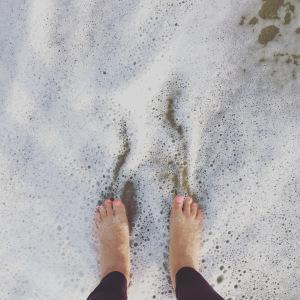
It has been an emotional roller coaster, and I have learned so much about myself along the way. At this point, I finally feel as though I am heading in the right direction.
Here are the top 10 things I recommend you do if you have plantar fasciitis:
1) Active Release Therapy & Graston. Plantar fasciitis is a chronic thickening of the fascia and build up of scar tissue in the arch and heel of the foot. In order to reduce pain and increase mobility of the foot, it is important to break up the scar tissue in the foot and also in the muscles of the lower leg, particularly the calf and toe flexors. Finding a specialist who could do this will be extremely important for optimal healing. Sometimes muscles can become so tight and scar tissue so thick that it entraps nerves and makes the pain even more constant. If you can find someone who specializes in ART for nerve entrapment, that may be especially helpful to you as I think it has been for me.
2) Daily foam rolling & trigger point release self-care. Healing is going to be a commitment, and as such will require doing the little things that will add up to big changes. Taking the time to massage your body with a good foam roller and with your hands is really helpful. I love the NANO Foot Roller and GRID Foam Roller from TriggerPoint Therapy.
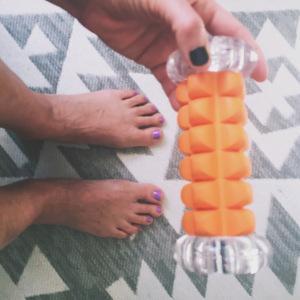
There are some great release techniques shared in Myriam Kane’s series for runners on Pilates Anytime. I highly recommend that you take the time to watch Myriam’s videos and apply these techniques. You can use code MYRIAM to get a month free on the site (otherwise it’s $18, which is a steal in my honest opinion).
3) “Toe Yoga” for improved foot dexterity. When I first went to the physical therapist, he asked me to do a few exercises with my toes that literally I COULD NOT DO for the life of me. I thought he was joking, and I called them Jedi mind tricks. I could not keep my great toe pressed into the floor while lifting all the others up. This was impossible for me. Because of all the inflammation, stress and thickening of the fascia in my medial arch, my toe flexor muscles just weren’t firing or working properly. Over time, I learned how to move my big toe separately from the others, how to splay my toes without moving my ankles and shins and how to lift and curl my toes with amazing ease. It took practicing this every single day. I am amazed at how I have been able to train my feet to move properly. My chiropractor says that foot dexterity is a hugely important piece of living an active, healthy and pain-free life. Every endurance athlete should take time to do this, even if you don’t have plantar fasciitis. I am really proud of my toe yoga these days and I believe it is going to help me a lot down the road.
4) Physical therapy exercises to correct imbalances. Have you ever heard the saying “where it is, it ain’t”? Well, it is absolutely the truth when it comes to plantar fasciitis, and honestly most chronic injuries. The foot is a victim of something else going on in your body. A good sports chiropractor or physical therapist can help you figure out what imbalances are at the root of your issue, and give you specific exercises to correct them. These exercises will serve the purpose of training proper neuromuscular firing patterns and healthy, efficient movement. They will teach you to activate and strengthen areas of your body that will help your feet heal and also protect you from having the injury recur. Be diligent and dedicated to your prescribed plan. This really matters. I believe that injuries can make us stronger later if we commit to doing the little things to get better.
5) Ultrasound treatments at home. Ultrasound is indicated as helping heal plantar fasciitis by sending heat to the deeper layers of facia via sound waves. Some chiropractors have expensive equipment in their offices and this may or may not be covered by your insurance. I found an at-home device on sale at TENSPROS (around $40) and I think it is really helping me. My chiropractor recommends using it twice a day for about 10 minutes. I put a generous amount of the conductive gel on my foot and continuously move the device across the area.
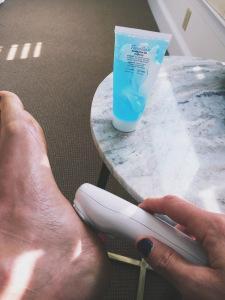
6) Toe Separator. This little device looks a lot like what you might use to keep your toes apart when you paint your nails (and I have used it for that!), but it serves a much greater purpose for the runner with plantar fasciitis. The toe separator helps with foot alignment and creating space between your toes, allowing you to activate the muscles properly and putting less strain through the arch, heel, achilles and calf. I wear mine for about 5 or 10 minutes a couple of times a day. My favorite time to wear them is while in a hot epsom salt bath!
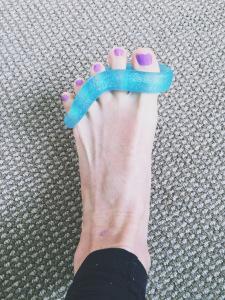
7) QuickTape/low-dye taping. Taking the load off your heel and arch is made much easier with a good quality taping from your chiropractor or physical therapist and usually lasts up to a few days. The only problem is that usually we aren’t seeing our doctor again right away, and we might not know how to tape the foot up again for ourselves without assistance. QuickTape low-dye taping that is pre-cut for plantar fasciitis is amazingly effective, very comfortable and easy to use. It comes with simple directions and stays on for several days.
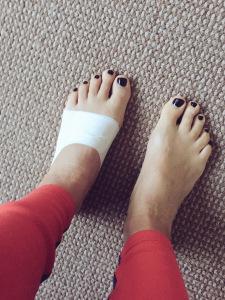
8) Journal. One thing I have learned is that setting intentions in the morning makes a big difference to my day. When you are hurt I think it is especially challenging to focus on the positives. Your body is hurting, something you love has been removed from your life for an undetermined period of time. It kind of sucks! BUT the practice of taking time each morning to set three goals for the day and take note of three things you are grateful for – things that have nothing at all to do with your injury – can really alter how you see things and how you approach your day. My sister loves snowboarding and she has this analogy that has always stuck with me. She says that when you snowboard if you focus on the trees, you are going to run into them! I think healing is similar – if we focus on what is hurting us and what we CAN’T do, then we are only going to hurt more and feel more crippled by our pain. My journal is a space I can use to create and design my life. Sure, sometimes I vent in there and get it all out in a messy whirl and that is helpful too! I think honoring all our feelings is important and healthy. It’s also your space to decide your choice in attitude for the day. Each day is a new beginning, and every day that you choose to heal and focus on what feels GOOD, is a day you are closer to getting better.
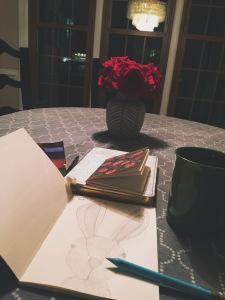
9) Reducing overall stress. Plantar fasciitis is a chronic injury. Even though it might seem like it just showed up one day, it is very likely that it was brewing inside you for a long, long time. Whatever the cause, healing is going to be hindered by a stressful life. Many endurance athletes are in a chronically stressed state just by nature of our sport plus the fact that so many of us are type-A folks who are operating on all cylinders most of the time! An injury like plantar fasciitis is kind of like your body’s way of waving a white flag. It’s under distress and needs a break. Use the time you are healing your foot as an opportunity to slow down and move in more gentle ways. My favorite ways of reducing stress have been taking yoga classes and sitting in the sauna or steam room. I also allowed myself more days to sleep in and snuggle with my family in the mornings. I made a list of all the things I love to do that bring me joy and make me smile, and added them to my goals in the mornings. It is amazing how much these little things help me! I feel like hobbies and passions that I didn’t have time for when I was running and training at full force all the time, found their way back into my life. I can’t tell you how much happier I am because of that. The stress in my life is greatly reduced, even without what I always thought was my biggest stress-reliever.
10) Not running – and not setting running goals. Move in other ways – and set other goals! I know, this is probably not what you want to hear…but I absolutely believe it’s an important and essential step to truly healing and being stronger on the other side of this injury. I stopped running when my foot began hurting, and each time as it started to feel somewhat better (but admittedly not ALL better, just maybe “better enough” or so I hoped) I would try to run again. I would get excited that I was finally feeling like myself again, and then the pain would return and I would be SO disappointed. I would run with anxiety and fear, which took all the joy out of running for me. It had me questioning what I was doing and why. I found other ways to move that felt amazingly good to my body – swimming, strength workouts with my husband, spinning, yoga and Pilates all brought me a tremendous amount of happiness and strength. It wasn’t until I really LET GO of my running, that I started to feel like maybe I could heal from this. I believe in my heart that the joy and ease of running pain free WILL return to me, and that I will actually likely have even more appreciation for it when it does! I also believe that I will return to it a stronger, healthier and more balanced person who happens to also be a kickass runner. I decided that the cross-training activities I was doing didn’t need to serve the purpose of getting me back to running, but that they had their own intrinsic value and worth to me. I am now looking into signing up for my first swim meet or open water swim, and am excited to pursue this new goal! Knowing that I can do so without potentially injuring my foot or hindering its healing, makes it all the more awesome and appealing to me.
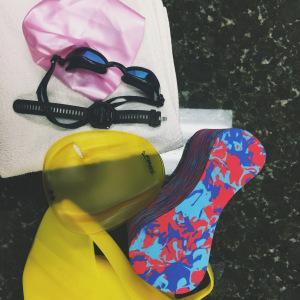
If you are reading this and are suffering from plantar fasciitis, my heart really does go out to you. Trust me, I have wanted to start a support group for those of us with this condition! I realized lately though that it doesn’t have to be something we are “suffering” from. I think injuries like this can be our greatest teachers once we stop trying to fight their lessons. For so long I thought running was this HUGE part of who I am … but when it was taken away from me I realized that while it is something I truly love I am in fact so much MORE than a runner. I think I actually have plantar fasciitis to thank for that. Here’s to every step of our journey, even the ones that we take with painful feet.
Have you tried any of these methods or practices for healing your plantar fasciitis? Are there any useful tips you would add to the list? I hope this article can be a helpful resource for many!

